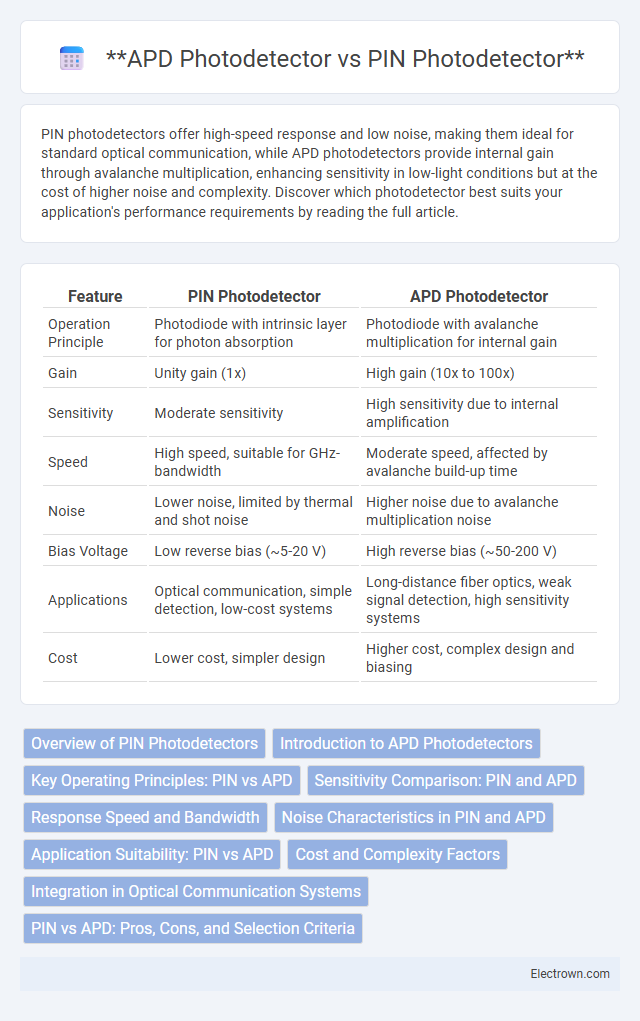PIN photodetectors offer high-speed response and low noise, making them ideal for standard optical communication, while APD photodetectors provide internal gain through avalanche multiplication, enhancing sensitivity in low-light conditions but at the cost of higher noise and complexity. Discover which photodetector best suits your application's performance requirements by reading the full article.
Table of Comparison
| Feature | PIN Photodetector | APD Photodetector |
|---|---|---|
| Operation Principle | Photodiode with intrinsic layer for photon absorption | Photodiode with avalanche multiplication for internal gain |
| Gain | Unity gain (1x) | High gain (10x to 100x) |
| Sensitivity | Moderate sensitivity | High sensitivity due to internal amplification |
| Speed | High speed, suitable for GHz-bandwidth | Moderate speed, affected by avalanche build-up time |
| Noise | Lower noise, limited by thermal and shot noise | Higher noise due to avalanche multiplication noise |
| Bias Voltage | Low reverse bias (~5-20 V) | High reverse bias (~50-200 V) |
| Applications | Optical communication, simple detection, low-cost systems | Long-distance fiber optics, weak signal detection, high sensitivity systems |
| Cost | Lower cost, simpler design | Higher cost, complex design and biasing |
Overview of PIN Photodetectors
PIN photodetectors feature a p-type, intrinsic, and n-type layer structure, enabling efficient photon absorption and conversion into electrical current with low noise levels. Their fast response time and linearity make them ideal for high-speed optical communication systems and data transmission. While typically exhibiting lower gain than APD photodetectors, PIN photodetectors offer simpler design and lower operating voltage requirements.
Introduction to APD Photodetectors
APD photodetectors offer high sensitivity by utilizing avalanche multiplication to amplify weak optical signals, making them ideal for low-light applications. Compared to PIN photodetectors, APDs provide higher gain and improved signal-to-noise ratio, which enhances detection performance in fiber optic communication and LIDAR systems. Your choice of APD ensures more efficient photon detection when precise and amplified responses are critical.
Key Operating Principles: PIN vs APD
PIN photodetectors operate by generating electron-hole pairs within an intrinsic semiconductor layer when exposed to light, resulting in a photocurrent proportional to the incident optical power. Avalanche photodiodes (APDs) amplify this photocurrent through impact ionization, where a high reverse-bias voltage creates a multiplication region that increases sensitivity and signal gain. Your choice between PIN and APD photodetectors depends on the required sensitivity, speed, and noise performance for optical communication or sensing applications.
Sensitivity Comparison: PIN and APD
APD photodetectors exhibit higher sensitivity than PIN photodetectors due to their internal avalanche gain mechanism, which amplifies the photocurrent resulting in enhanced signal detection at low light levels. PIN photodetectors offer lower noise performance but lack the gain, making them less sensitive when detecting weak optical signals compared to APDs. The choice between PIN and APD depends on the application's sensitivity requirements and the acceptable noise level for optimal photodetection.
Response Speed and Bandwidth
PIN photodetectors offer faster response speeds and wider bandwidths due to their simple structure and shorter carrier transit times, making them ideal for high-speed optical communication. Avalanche photodetectors (APDs) provide internal gain through avalanche multiplication, enhancing sensitivity but typically at the cost of slower response times and narrower bandwidth caused by the avalanche process. Optimizing PIN photodiode designs can achieve bandwidths exceeding tens of GHz, while APDs generally operate with bandwidths in the lower GHz range, balancing gain and speed depending on application demands.
Noise Characteristics in PIN and APD
PIN photodetectors exhibit lower noise levels due to their simple structure and absence of internal gain, making them ideal for applications requiring low noise and high linearity. Avalanche photodetectors (APDs) introduce gain through avalanche multiplication, which amplifies the photocurrent but also increases excess noise factor, resulting in higher noise compared to PIN detectors. Understanding the noise characteristics of PIN and APD photodetectors helps you choose the right device based on the trade-off between sensitivity and noise performance.
Application Suitability: PIN vs APD
PIN photodetectors are ideal for high-speed, low-noise applications such as fiber optic communication systems and barcode scanners due to their linear response and wide bandwidth. APD photodetectors offer built-in gain through avalanche multiplication, making them suitable for low-light or long-distance applications like LIDAR and optical range-finding where higher sensitivity is critical. Your choice depends on the trade-off between noise performance and sensitivity requirements in your specific application.
Cost and Complexity Factors
PIN photodetectors are generally more cost-effective and simpler to manufacture due to their straightforward structure and lower bias voltage requirements. Avalanche photodetectors (APDs) involve more complex fabrication processes, higher operating voltages, and integrated gain mechanisms, increasing both cost and design complexity. The need for precise temperature control and quenching circuits further elevates APD system expenses compared to the more economical and easily implemented PIN photodetector solutions.
Integration in Optical Communication Systems
PIN photodetectors offer straightforward integration in optical communication systems due to their simple structure and lower bias voltage requirements, making them ideal for short-distance data transmission. Avalanche photodetectors (APDs) provide higher sensitivity and gain through internal multiplication, which enhances performance in long-haul or high-speed fiber optic networks, despite requiring more complex biasing and temperature control. Your choice between PIN and APD photodetectors should consider system requirements such as distance, signal strength, and cost efficiency.
PIN vs APD: Pros, Cons, and Selection Criteria
PIN photodetectors offer lower noise and higher linearity, making them ideal for applications requiring stable and accurate signal detection under moderate light levels, while APD photodetectors provide internal gain through avalanche multiplication, enhancing sensitivity in low-light environments but at the cost of higher noise and increased complexity. The selection between PIN and APD depends on factors such as required sensitivity, signal-to-noise ratio, bandwidth, and power consumption, where APDs suit long-distance fiber optics or weak signal detection, and PINs are preferred for cost-effective, high-speed systems. Your choice should balance performance needs with system constraints to optimize detection efficiency and reliability.
PIN photodetector vs APD photodetector Infographic

 electrown.com
electrown.com